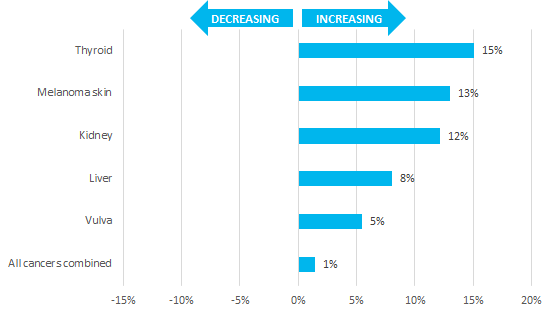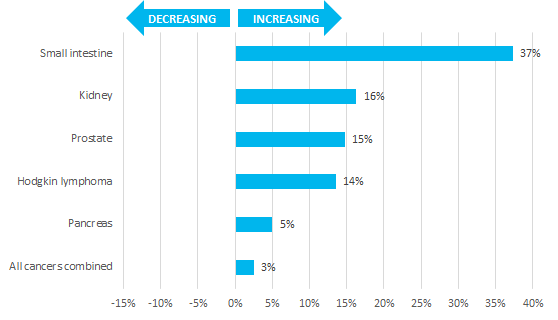Breast cancer is the most common cancer in the UK, accounting for around 3 in 20 (15%) of all cases in females and males combined (2017-2019.[1-4] The next most common cancers in UK people are prostate (14%), lung (13%), and bowel (11%). Though there are hundreds of cancer types, just these four types - breast, prostate, lung and bowel - together account for more than half (53%) of all new cases in the UK (2017-2019). [1-4] The two most common cancer types occur mainly or exclusively in only one gender.
The 20 Most Common Cancers, UK, 2017-2019

This chart excludes non-melanoma skin cancer because of known under-reporting. Data in this chart do not sum to the all cancers combined total provided elsewhere, because 'brain, other CNS (central nervous system) and intracranial' includes tumours that are malignant and non-malignant but only the malignant tumours are included in 'all cancers combined' total.
References
-
England data were provided by the National Cancer Registration and Analysis Service (NCRAS), part of the National Disease Registration Service (NDRS) in NHS England, on request through the Office for Data Release, January 2023. Similar data can be found here: https://www.cancerdata.nhs.uk/
-
Northern Ireland data were provided by the Northern Ireland Cancer Registry (NICR) on request, October 2021. Similar data can be found here:http://www.qub.ac.uk/research-centres/nicr/.
-
Welsh data were published by the Welsh Cancer Intelligence and Surveillance Unit (WCISU), Health Intelligence Division, Public Health Wales https://phw.nhs.wales/services-and-teams/welsh-cancer-intelligence-and-surveillance-unit-wcisu/cancer-reporting-tool-official-statistics/ June 2022.
-
Scotland data were provided by the Scottish Cancer Registry, Public Health Scotland (PHS) on request, May 2021. Similar data can be found here: https://publichealthscotland.scot/publications/show-all-releases?id=20468
Data is for UK, 2017-2019, ICD-10 codes: All cancers excluding non-melanoma skin cancer (C00-C97 excl. C44), Bladder (C67), Bowel (C18-C20), Brain, Other CNS and Intracranial Tumours (C70-C72, C75.1-C75.3, D32-D33, D35.2-D35.4, D42-D43, D44.3-D44.5), Breast (C50), Cancer of Unknown Primary (C77-80), Head and Neck (C00-C14, C30-C32), Kidney (C64-C66,C68), Leukaemia (C91-C95), Liver (C22), Lung (C33-C34), Melanoma Skin Cancer (C43), Myeloma (C90), Non-Hodgkin Lymphoma (C82-C86), Oesophagus (C15), Ovary (C56-C57.4), Pancreas (C25), Prostate (C61), Stomach (C16), Thyroid (C73) and Uterus (C54-C55)













